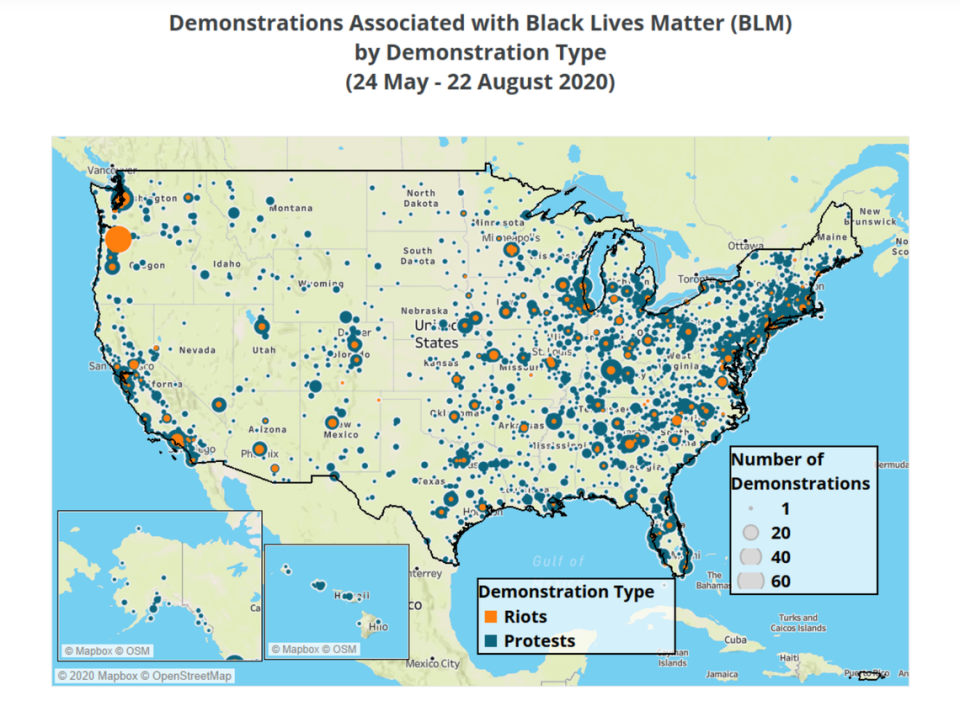Over 90% of Black Lives Matter demonstrations this summer were peaceful, analysis shows
A report analyzing the flash point of Black Lives Matter protests across the U.S. this summer found more than 90 percent of the demonstrations against racial injustice were nonviolent.
An analysis by the nonprofit Armed Conflict Location and Event Data Project identified more than 7,750 demonstrations across 2,400 cities between May 26 — the day after the death of George Floyd — and Aug. 22.
Fewer than 220 of those events were marked by violence or destructive activity and were “largely confined to specific blocks,” according to the report.
“The vast majority of the demonstration events associated with the BLM movement are non-violent,” the group’s analysis reads. “In more than 93% of all demonstrations connected to the movement, demonstrators have not engaged in violence or destructive activity. Peaceful protests are reported in over 2,400 distinct locations around the country.”

Nationwide protests against police violence and racial injustice surged after the killing of Floyd, an unarmed Black man who died in police custody May 25 when a Minneapolis officer knelt on his neck for about eight minutes. Three other officers failed to intervene as Floyd, 46, complained that he could not breathe. All four officers have since been fired and criminally charged.
Floyd’s final moments were captured on camera, sparking national outcry and demands for police reform.
Police arrest 2 after another night of Jacob Blake marches in downtown Sacramento
California, New York, Florida and Illinois saw the vast majority of BLM-linked protests this summer, data show.
More recently, demonstrators have taken to the streets in Kenosha, Wisconsin, where police were seen on video shooting an unarmed Black man, Jacob Blake, seven times in the back.
Blake’s father, Jacob Blake Sr., said his son is now paralyzed from the waist down, CNN reported.
While protests have remained “overwhelmingly” peaceful, researchers warned that “violent political polarization” could intensify ahead of the November election.
“In this hyper-polarized environment, state forces are taking a more heavy-handed approach to dissent, non-state actors are becoming more active and assertive, and counter-demonstrators are looking to resolve their political disputes in the street,” authors wrote. “Without significant mitigation efforts, these risks will continue to intensify in the lead-up to the vote, threatening to boil over in November if election results are delayed, inconclusive, or rejected as fraudulent.”
The ACLED analysis also highlights the disproportionate police response to the protests, noting that one in 10 Black Lives Matter protests have been met with state-sanctioned intervention compared to 3% of all other demonstrations. Though police were there to keep the peace, the authors said militarized law enforcement presence actually stokes tensions.
Sacramento City Council to debate ‘defunding’ millions from police, fire budgets
“In demonstrations where authorities are present, they use force more often than not,” according to the report. “Data show that they have disproportionately used force while intervening in demonstrations associated with the BLM movement, relative to other types of demonstrations.”
The report also points to other issues that have shaped protest trends in the country, including the coronavirus pandemic, hate crimes and violence targeting women.
Other key findings from the ACLED analysis include:
The group identified more than 100 events in which non-state actors intervened in demonstrations including militia groups, hate groups and individual agitators.
Armed individuals are becoming more prevalent at protest events.
State intervention and use of force at demonstrations have increased compared to this time last year.

